Fujifilm XF10 Review
Fujifilm XF10 Introduction
The Fujifilm XF10 is a Premium Compact digital camera with a 24 Megapixels APS-C CMOS sensor, which is the same size used in Fujfilm mirrorless and most DSLRs. This large sensor is paired with a fixed Fujinon 18.5mm F/2.8 prime lens, equivalent to 28mm on a full-frame camera, giving a wider perspective than on the flagship X100F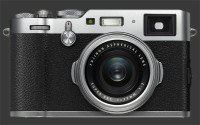
Fujifilm X100F which sports a lens equivalent to 35mm.
Similarly specified to the sensor in the X-A5, the one in the XF10 also uses a conventional Bayer Color-Filter Array with Anti-Alias Filter to prevent moire from becoming an issue. On the sensor, there is a 91-Point Phase-Detect AF system. A hybrid leaf shutter allows the XF10 to cover a shutter-speed range of 1/16,000-30s, plus Bulb exposures up to an hour, something rarely possible on a compact digital camera.
Although minimalisctic, the design of the XF10 offers efficient access to all exposure parameters with its dual control-dials, lens control-ring, traditional mode-dial and joystick-style controller. Unusually for a Premium Compact, the XF10 omits both a viewfinder and a 4-way controller to keep its size and weight incredibly low.
This camera review takes a close look at the Fujifilm XF10 in terms of features, its ergonomics, usability, performance and image quality.
Fujifilm XF10 Features
Sensor
- 2 Megapixels APS-C CMOS sensor
- Anti-Alias & Bayer Filters
- Built-in Phase-Detect autofocus
- ISO 200-12800 range, 1/3 EV steps
- Expanded ISO 100-51200 range, JPEG only
- Customizable Auto ISO, 3 settings
- JPEG, RAW or JPEG+RAW Output
- 3840x2160 @ 15 FPS 4K Ultra-HD Video
- 1920x1080 @ 30 FPS Full HD Video
- 1920x1080 @ 100 FPS High-Speed Video
Lens
- Fujinon 18.5mm, equivalent to 28mm
- F/2.8 - F/16 Aperture range, 1/3 EV steps
- 9-Blade Aperture
- Leaf-Shutter
- 10cm Normal minimum focus distance
- Depth-of-Field Preview
Exposure
- PASM Exposure modes
- 1/16000s-30s Shutter-speeds
- Bulb exposures up to 1 hour
- Exposure-Compensation, ±5 EV, 1/3 EV steps
- Flash-Compensation, ±2/3, 1/3 EV steps
- Multi-Segment, Spot & Average metering
- AEB, 2-9 Frames, ±3 EV, 1/3 steps
- ISO Bracketing, ±1 EV, 1/3 steps
- Auto HDR, 2 Frames, 1-3 EV step
- Fixed 1/3 EV exposure steps
Images Parameters
- Automatic, Preset, Kelvin and Custom WB
- WB fine-tuning, 19-steps along 2-axis
- Film Simulation: Provia, Velvia, Astia, Classic Chrome, Pro Negative High, Pro Negative Standard, B&W, B&W+Red Filter, B&W+Green Filter, B&W+Blue Filter, Sepia
- 100-400% Automatic or Manual Dynamic-Range
- Adjustable color-saturation, 5 steps
- Adjustable sharpness, 5 steps
- Adjustable highlight-tone, 5 steps
- Adjustable shadow-tone, 5 steps
- Adjustable noise-reduction, 5 steps
- Film Simulation Bracketing, 3 frames
- Optional Long-Exposure Noise-Reduction
Focus & Drive
- 91-Point Phase-Detect AF system
- Auto or Single, Zone or Wide Focus-Point Selection
- Single-Shot, Continuous, DMF or Manual Focus
- Face & Eye-Detect AF with Eye-Priority
- 6 or 3 FPS Drive, Max 13 JPEG
- 2s, 10s, Face, Smile, Buddy, & Group Self-Timers
- Motion Panorama, 180° & 120° angle-of-view
- Interval Timer: 1-999 Frames, 1s-24h Interval, 0-24h Delay
- Built-in Time-Lapse Video, Max 4K @ 30 FPS
- Multiple-Exposure, 2 frames
- Optional AF-Assist lamp
Display
- 3" Touchscreen LCD
- 1 megapixel
- 100% coverage
- Digital-Level, 1 axis, tilt only
- Optional MF-Assist
- Optional Focus-Peaking
Controls
- Dual Control-Dials
- Standard Mode Dial
- Customizable Lens Control Ring
- Customizable Function button
- Fly-By-Wire manual focusing
Body & Construction
- Built-in flash, 7.5m reach
- Wired remote mini-jack
- Audio input mini-jack
- Metal tripod mount
- 4K HDMI output
- Builtin WiFi
- Bluetooth 4.1 LE
- USB 2.0 connectivity
- SDXC memory card slot
- Proprietary Lithium-Ion battery
- Internal Charging via USB
Fujifilm XF10 Usability - How easy is it to use?
Fujifilm made the XF10 as compact as possible for a digital camera with an APS-C sensor. While this is the same sensor size used in their mirrorless system, the XF10 weighs only 330g and is a mere 41mm thick. When powered on, the lens extends just a few millimeters out. Its body is largely rectangular with a slight hand-grip, just enough to hold onto the camera tightly, if needed. A very nice leather wrist-strap with tightening element is provided for added safety.
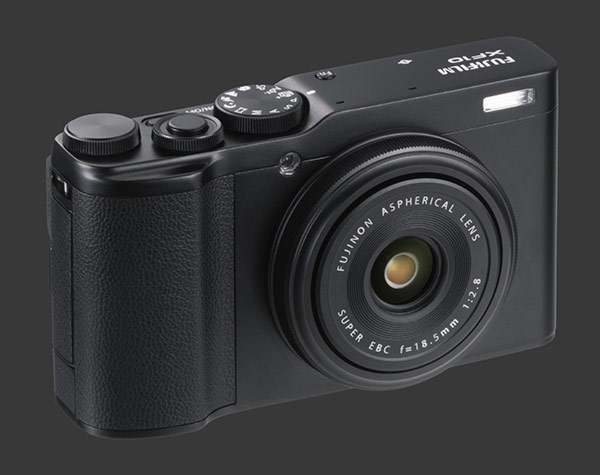
Given its small size and unassuming design, this digital camera can easily be mistaken for an entry-level compact. Of course, the XF10 is much more capable and Fujifilm built it to match. The entire camera feels sturdy with a good density and a smooth luxurious matte finish. There is a cover with a fine rubber texture on the front of the hand-grip and at the back to rest the thumb. All the dials have a fine texture on the outer edge to prevent slippage.
What really defines the Fujifilm XF10 is its combination of a fixed prime lens and highly compact size. The lens itself is a crucial usability consideration. Its fixed focal-length, equivalent to a wide 28mm on a full-frame camera, is very different to use than a zoom. While this makes it possible to have an APS-C sensor in such a small camera, not everyone is going to be satisfied with it. Framing with a prime lens requires much more freedom of movement and a different way of seeing things. The angle-of-view is fixed, so one must learn to look at subjects with than angle-of-view in mind.
The front of the Fujifilm XF10 is quite sparse. The lens is obviously there with a small front-element, despite have a relatively bright F/2.8 maximum aperture. The lens is surrounded by a control-ring which rotates smoothly around the barrel. Its behavior is customizable to change Focus-Distance, ISO, WB, Film Simulation or Dynamic-Range.Above the left side of the lens, there is a small illuminator which optionally can be used to help focus in the dark at close proximity. A tiny flash is found on the upper-right corner of the front plate.
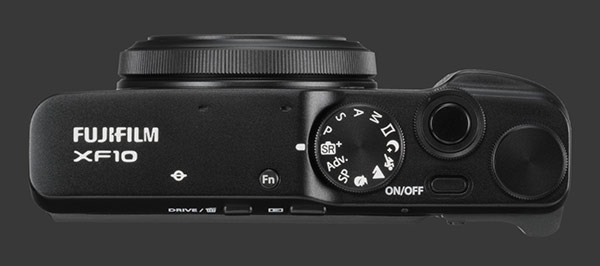
On top of this digital camera, one finds dual control-dials, a traditional mode-dial and two buttons. The oval one turns the camera on or off, while the tiny round one is customizable to one of 36 functions! There are many features to choose from. Some though, such as Depth-of-Field Preview, can only be accessed via that button. Unfortunately, this button is rather small and its placement is not great. Outside of Manual mode, the rear control-dial applies Exposure-Compensation. In the center of the front control-dial, there is a shutter-release with short travel but a firm halfway point.
The mode-dial offers 11 positions to choose from. The ubiquitous PASM modes are all there. P mode can be shifted using the front control-dial.M mode offers a Shutter-Speed range of 1/4000s-30s when using the mechanical-shutter or 1/16000s-30s with the electronic one. It also allows for Bulb exposures of up to an hour, something nearly no other compact camera can do. The aperture range is always F/2.8-16.
Fujfilm put a direct position on the mode-dial for Motion Panorama. This takes a panoramic image with 120° or 180° field-of-view in any of the 4 cardinal directions. Night, Sport, Landscape and Portrait scene modes are each given their own position. Remaining scene modes are kept under SP which also hide the Multiple-Exposure feature. The Adv position is there for in-camera filters. Finally, SR+ continually analyzes the scene to automatically select a scene mode. This is a very capable feature for beginners but beware that it puts noticeably more strain on the battery.
The left side of the camera is bare, while the right has a rigid flap which covers three ports: Mic/Remote, Micro-HDMI and Micro-USB. The first supports a wired-remote or external stereo microphone. The second can output 4K over HDMI yet not while also writing to the card, so one must choose between 4K Recording and 4K Output. The Micro-USB port is used for charging since Fujifilm unfortunately does not supply a dedicated battery-charger with the camera. This has the downside of tying up the camera while a battery is charging.
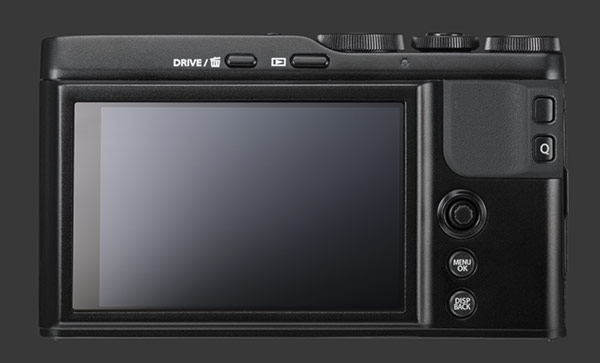
Inspired by the unconventional yet highly successfull design of the X-E3, the XF10 offers a similar back which looks minimalistic while remaining quite functional. The XF10 is very small and so its 3" LCD covers most of the space. This display is a touchscreen with one megapixel of resolution. It appears reasonably sharp with good visibility and viewing angle. By default it is overly bright, misleading the user into thinking that images are being over-exposed, yet this can easily be corrected. The preview is not completely Exposure-Priority, yet provides a reasonable approximation down to low light-levels. Note that this is not the default in M mode, so this must be changed in the Settings menu.
Right above the LCD, there is a distinct lack of a viewfinder. There no provision to add one either. This is certainly the most signigicant limitation of the XF10 which is a rare choice among Premium Compact Digital Cameras. Instead, the Drive/Delete and Playback buttons are found on the small edge above the display. In Capture mode, Drive brings up a long list of drive modes and prompts for deletion in Playback mode. The Playback button itself toggles between Capture and Playback modes. It does not power the camera on though as is possible on some models.
To the right of the LCD, there is no 4-way controller to be found. This was first done by Fujifilm with the X-E3, replacing the standard behavior of the 4-way controller by an 8-way joystick. This works beautifully, although the joystick is a little low on the XF10. Still, it makes it very easy to navigate menus and move the focus point or area. The joystick itself is clickable too which serves to replace the central button on most 4-way controller. There is just below it a combined Menu/OK button which can also be used to confirm selections. Directly below, there is Disp/Back button which cycles over display modes or goes back one level while using the menu system.
On the upper right corner of the back, a rubber-coated thumbrest curves outwards to provide good purchase over the camera. There are two buttons on the outer edge of the thumb-rest. The unmarked one is customizable to the same 36 functions as the Fn button on the top plate. Below it, a buttom marked Q invokes the now-classic Fujifilm 4x4 icon menu. The joystick is used to select an option and the rear control-dial changes it. The menu itself is completely customizable to place 16 functions close-by.
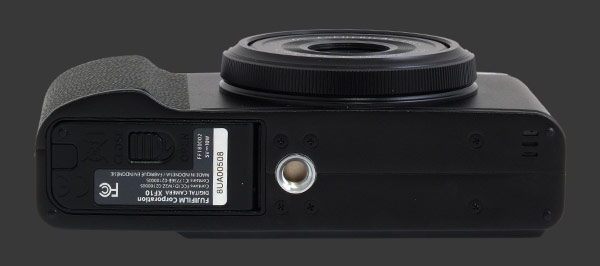
The bottom of the XF10 has a metal tripod mount which is neither inline with the lens nor the center of the camera. This is also where the combined battery and memory compartment is located. Given that the compartment door is so close to the tripod mount, it is not possible to change batteries or memory cards while the camera is mounted on a tripod.
In use, the Fujfilm XF10 is efficient yet demanding. Controls are easy to operate and make it easy to change settings as required. Using the lens control-ring as third control-dial, one can have all exposure parameters readily available. Plus, the joystick makes choosing focus very quick too. On the other hand, the lack of a viewfinder and the fixed focal-length lens makes it more effort from the part of the photographer. Holding the camera away from the body removes stability and makes the photographer more conspicuous. Speaking of stability, the XF10 is one of the few modern digital cameras to ommit image-stabilization.
Fujifilm XF10 Performance - How well does it take pictures?
Fujifilm built the XF10 around a 24 megapixels APS-C CMOS sensor. This is likely to be the same one used in the X-A5 mirrorless and features a conventional Bayer Color-Filter Array and Anti-Alias Filter, rather than the unique-to-Fujifilm and more expensive X-Trans sensor in the range-finder style X100T reviewed here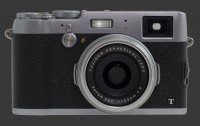
Fujifilm X100T. This is as large a sensor as fits a digital camera this small and is made to give it superior low-light performance thanks to its larger surface area.
At 24 megapixels, this sensor captures plenty of fine details with very good sharpness, particularly so since it is matched with a custom 18.5mm F/2.8 lens. This APS-C sensor offers a standard ISO 200-12800 sensitivity range, which is expandable to ISO 100 and ISO 25600-51200. Only a handful of APS-C sensors are more sensitive. Given that the Expanded range is generated via processing, it is only available in JPEG format. RAW files can be taken throughout the standard ISO range though.
The XF10 shows virtually no image noise from ISO 200 to 6400. Within this range, details remains very sharp and very good black levels. Micro contrast is excellent throughout this sensitivity range. Both Sharpness and Noise-Reduction are adjustable in 5 steps which can fine-tune the output to taste. The default sharpness is just a tad over-sharpened, while default noise is well-balanced.
The Expanded Low ISO 100 setting though is digitally expanded to maintain the same overall contrast as ISO 200 yet this increases micro-contrast which emphasizes noise. While noise remains rather low, this sensitivity is just not as clean the native ISO of the sensor. It also clips dynamic-range in highlights by roughly one stop.
Slight image noise starts appearing at ISO 12800. There is actually more noise at this sensitivity which is hidden by noise-reduction. This causes sharpness to go down and fine details a little softer. Still, this is a very good performance for any digital camera, particularly a compact one. The two Expanded High-ISO levels, 25600 & 51200, each show a notable jump in noise and diminishing contrast. ISO 25600 though remains quite usable for small to mid-size prints. ISO 51200 does not appear much noisier but is significantly softer due to noise-reduction. This leaves it usable for the smallest prints.
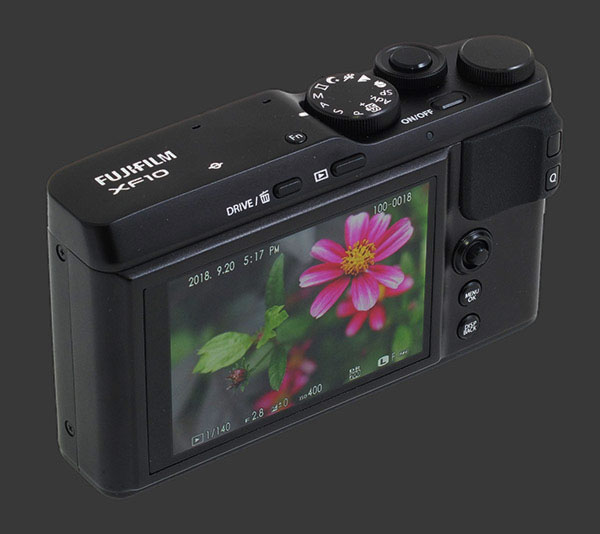
Dynamic-Range is configurable by sensitivity. The maximum range of 400% is quite impressive and available from ISO 800 to 12800. Between these sensitivities, the XF10 delivers very good dynamic-range, easily competing with DSLRs and mirrorless cameras. ISO 400 and above offer 200% dynamic-range which compares to the range offered by modern cameras with APS-C sensors. All other sensitivities are restricted to 100% Dynamic-Range which is still fairly good.
The sharpness of the Fujinon Super EBC 18.5mm F/2.8 lens on this camera is truly excellent and highly consitent across the aperture range. There is a hint of softness at extreme corners, yet nothing that can be noticed on anything but the largest prints. Distortion and vignetting are both completely absent from images which shows that Fujifilm truly optimized this lens for the XF10 sensor. A little chromatic aberration appears in edges of extreme contrast, such as strongly backlit subjects.
While the performance of this is is truly impressive, it lacks image-stabilization. This is very rare these days, particularly among Premium Compact Digital Cameras such as this one. The other ommission from the lens is a filter-thread. While not a huge deal, having no option to use a polarizer can be limiting. Note that there is no way to apply a polarizing effect in software as light polarity is not captured by the sensor.
Automatic while-balance is good but not perfect. In typical outdoor conditions, it generally does very well. In the presence of artificial light, mostly tungsten, it leaves a noticeable orange cast. Switching to a white-balance preset corrects this in most situations. Custom white-balance works as expected.
Metering is generally good on the XF10. For the majority of subjects, the Fujifilm meters quite accurately. The Multi-Segment metering pattern is somewhat heavily weighted around the image center which throws it completely off when sky only covers a small portion of scene. While most scenes only require a fraction of the stop to correct, it does happen that two or three stops EC are needed to avoid clipping of highlights. Keep in mind that the default LCD brightness is overly bright and makes many scenes look overexposed, even when they are not.
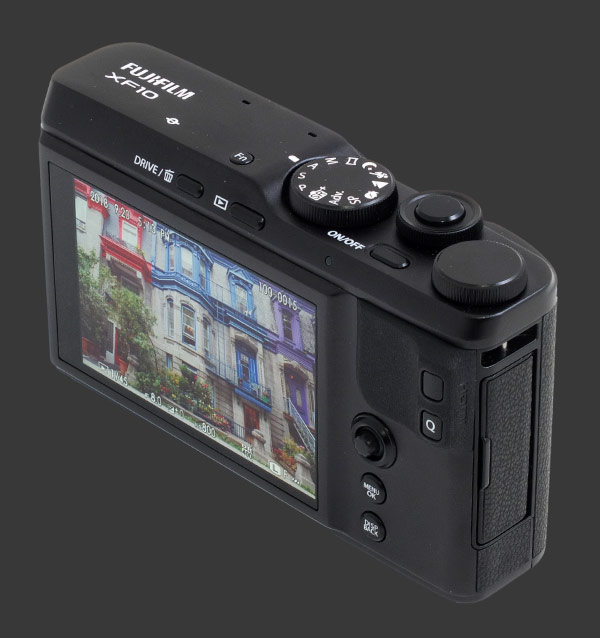
While the Fujifilm XF10 is highly responsive and mostly speedy, autofocus speeds are less impressive. All buttons, dials and the joystick get an instant response. The customizable lens control-ring has a tiny lag, which makes it seem like the first turn is being ignored. Still, it is very slight and one can easily get used to it.
The hybrid Phase-Detect and Contrast-Detect AF system of the XF10 is very accurate and extremely sensitive. Its speed is more average though, taking between ¼ and 1 second to lock. The AF system is quick and decisive in good light and drops down in performance when light is low. This is a very reasonable performance considering that the XF10 is much more sensitive than most compact cameras.
The performance of the Fujifilm XF10 is characterized by the following numbers:
- Power On: 1s, great.
- Power to first shot: 3s, below average.
- Autofocus: ¼s to 1s. From good to slow, depends on light. A little below average.
- Shutter-Lag: Instant with just over ¼s black-out. Very good.
- Shot-to-shot: Just under 1½s, below average.
- Playback: Instant to enter, ½s to exit. Good.
- Power-Off: ½s, very good.
- Video Record: 1s start delay, instant stopping. Slower than ideal, better than average.
The Fujifilm XF10 can continuously shoot full-resolution images at 6 FPS without pause until the memory card fills up. This is very impressive throughput, although the LCD is simply unable to keep up and shows more blackout than preview. This makes it very difficult to catch shoot moving subjects yet can be good to capture a fleeting expression.
All taken together, the XF10 shows average speed. Some numbers are better than usual, some not, which reflects its lower level status compared to the X100T. The most surprising performance number is the 1s video recording delay. This is normally typical of digital cameras that do not have a movie mode, yet the Fujfilm XF10 has one which, at leasts, allows it to preview video framing correctly.
Although much smaller than the X100T, the truly compact XF10 manages to deliver the same 330 shot-per-charge battery-life. This is about average for a small camera and can last a full day of shooting using available light, rather than 50% flash which is used to compute the official CIPA number.
Fujifilm XF10 Conclusion
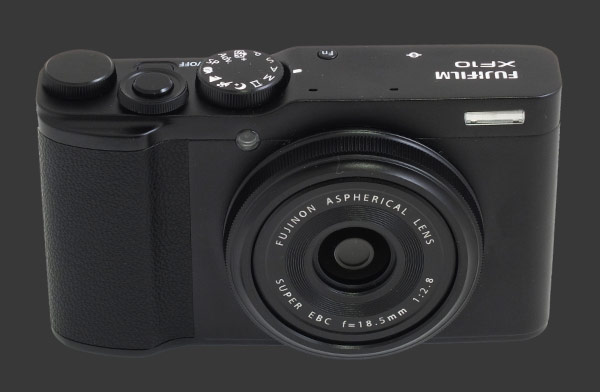
Fujifilm is offering a unique proposition with the XF10. This truly compact digital camera produces image-quality that rivals entry-level DSLRs and barely weights 330g, including a fast 18.5mm F/2.8 lens. Not only do DSLRs weigh more, just any F/2.8 lens alone would too! Such a small size offers great discretion compared to an interchangeable lens camera.
When it comes to image-quality, the Fujifilm XF10 delivers nicely. Image noise is incredibly low, while details are well captured up to relatively high sensitivities. There is just a notch less detail due to an anti-alias filter, now omitted by many cameras, and somewhat more aggressive noise-reduction than usual. Still, up to ISO 6400, the XF10 is really capable for producing sizeable prints.
One has to wonder how Fujifilm managed to produce a rather small lens with such stellar performance. Its optics are sharp eve wide-open with barely any softening near extreme corners. This lens shows no sign of vignetting or distortion either, only the occasional chromatic aberration in brightly backlit situations. Unlike most other modern fixed-lens cameras, the XF10 lack image stabilization.
Speed is decidedly average. Although it can shoot 24 MP images indefinitely at 6 FPS and is generally very responsive, camera functions are not so fast. Autofocus, in particular, is sluggish despite being very accurate and highly sensitivity. This comes down to have a very good sensor yet using a less powerful processor, most like to allow such a small camera to keep it powered.
Ergonomics of this digital camera are impressive considering its small size. The dual control-dials make controller efficient and the customizable stepless lens control-ring increases this further. The 8-way joystick serves really well to compensate for the loss of a 4-way controller too.
The real question is the cost required to make a camera with an APS-C sensor so compact. The first and most significant one is the fixed prime lens. At 18.5mm, which is equivalent to 28mm, all images from the XF10 have exactly the same perspective and it takes much more effort to frame with a prime lens than it does a zoom. The second is the lack of a viewfinder and no provision to add one. This is certainly a big deal for some people.
In the end, the Fujifilm XF10 excels in what it sets off to do: Deliver high image-quality in a truly compact form. These has to be a price for this and it is up to potential buyers to decide if they can accept the fixed lens, lack of a viewfinder and stabilization for it.
 |
Please Support Neocamera
All information on Neocamera is provided free of charge yet running this website is a huge endeavor. Purchases made via affiliate links found throughout the site help keep it running and up-to-date. There is no additional cost to you, so please consider buying via these links to our affilates:
If you found any information on this site valuable and did not purchase via our affiliate links, please considering donating via PayPal:
Any amount will be greatly appreaciated. Thank you for your support!
Fujifilm XF10 Highlights
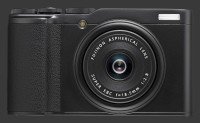
Sensor-Size: 24 x 16mm

Actual size when viewed at 100 DPI
| 24 Megapixels Fixed Lens | ISO 100-51200 |
| Fixed 28mm lens | Shutter 1/16000-30s |
| 1 Axis Digital Level | Full manual controls, including Manual Focus |
| 6 FPS Drive, 13 Images | Custom white-balance with 2 axis fine-tuning |
| 3840x2160 @ 15 FPS Video Recording | Spot-Metering |
| 3" LCD 1 Megapixels | Lithium-Ion Battery |
| Secure Digital Extended Capacity |
Updates
2025.01.18

Fujifilm GFX 2025 Lens Roundup
Lens Review roundup of Fujifilm GFX Medium-Format lenses. Quality, performance and handling of the GF20-35mm F/4R WR, GF30mm F/3.5 Tilt-Shift and the GF55mm F/1.7.
2024.11.18

Best 2024 Photography Gifts for Every Budget
Great gifts for photographers and photo enthusiasts selected for every budget among the best products of 2024.
2024.08.07

Eye Protection Tips for Professional Photographers
The four main considerations for professional photographers regarding eyewear.
2024.07.14

Fujifilm X100VI Review
Flagship fixed-lens compact digital camera with a 40 MP sensor and Image-Stabilization, a first for the series. Retro design featuring dual control-dials, plus direct ISO, Shutter-Speed and EC dials. Its hybrid viewfinder can switch between EVF and OVF mode.
2024.05.09

Fujifilm GFX100 II Review
Flagship 102 Megapixels Medium-Format Mirrorless Digital Camera with 8-Stop 5-Axis IBIS, 8 FPS Drive, 8K Video and 400 MP Super-Resolution capture in a weatherproof and freezeproof body with dual control-dials and dual memory-card slots.
2024.04.03

Fujifilm X-T5 Review
Newest Fujifilm flagship boasting a 40 MP APS-C sensor, 5-axis IBIS with 7-stop efficiency, 15 FPS continuous drive, 6.2K Video capture, dual control-dials and dual SDXC UHS-II slots in a sturdy weatherproof and freezeproof body.
2023.11.20

Best Digital Cameras of 2023
Find out which are the Best Digital Cameras of 2023. All the new Mirrorless Digital Cameras from entry-level to high-end professional.
2023.07.10

Fujifilm X-H2 Review
40 Megapixels APS-C Hybrid Mirrorless Digital Camera with 7-stop IBIS. Fastest shutter ever and 8K video capture. Large builtin EVF with 0.8X magnification and 5.8 MP, plus an Eye-Start Sensor. Packed with features and large number of controls in a weatherproof and freezeproof body.
2023.05.07

Sony FE 20-70mm F/4G Review
Review of the unique Sony FE 20-70mm F/4G lens. The optical zoom of this lens spans ultra-wide-angle and medium focal-length coverage, making it one of the most versatile Full-Frame lenses on the market.
2023.01.15

Huion Inspiroy Dial 2 Review
Review of the Huion Inspiroy Dial 2 tablet, a medium sized drawing surface with dual dials and customizable buttons. Connects via USB-C or Bluetooth 5.0 with Windows, Linux and Android support.
2022.12.08

How to Pack for a Photo Trip
Find out how to pack for a travel photography trip, carry your gear safely while meeting airline regulations.
2022.11.13

Best Digital Cameras of 2022
The best digital cameras of 2022. A short list of the most outstanding models in their respective categories. Choose one for yourself or as a gift.













